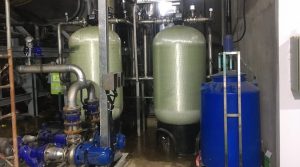REGENERATIVE HARD WATER SOFTENER SYSTEM USING MANUAL CONTROL VALVE (5-WAY VALVE)
- Salt content needed for regeneration: about 100-160g salt/liter of plastic beads, solution concentration 20%
- Water path: backwash goes down the pipe and then back up, the salt suction stage, downwash and water activity goes out the pipe from top to bottom to filter, filtered water goes out of the tank.
- Backwashing is intended to remove suspended residue and loosen plastic particles for at least 15 minutes.
- Suck in salt to perform ion exchange for at least 60 minutes
- While sucking salt, there must be a discharge line for the ion-exchanged solution to escape
- You should not soak salt in plastic beads because then the hardness ions Ca2+ and Mg2+ will not escape
- Wash the salt for 15-30 minutes, make sure to wash the salt book, check that the input and output TDS are equivalent to clean the salt.
- Do not put unsalted water into the tank, as this will corrode the equipment due to salinity.
PUMP WATER SOFTENER SYSTEM DOES NOT PUMP UP THE WATER
- It is relatively rare for the softener pump to not pump water, however, if not handled promptly, it will run out of water, and the boiler supply tank will run out of water, which is dangerous for boiler safety.
- The most obvious thing is that the pump does not produce water, the pressure gauge mounted on the pipe does not jump, and it feels hot to the touch.
- Reason
- Shallow water supply tank (not considered),
- The water tank is full, the pump runs but does not pump water due to “air gas”.
- How to fix:
- OFF Pump
- Open the valve to release the air in the pump and pipes
- Check pipes, leaks, leave valve in operating position
- Open the pump and operate normally
EFFECT OF THE PLASTIC GRAIN WASHING PHASE IN THE REGENERATIVE PROCESS OF THE WATER SOFTENER SYSTEM
- After a period of operation, the softening system is no longer able to exchange ions. At that time, it needs to be regenerated so that the resin can exchange ions again.
- The commonly used regeneration solution is NaCl salt, which has the effect of pushing hardness ions out of the plastic beads
- For effective regeneration, it is necessary to wash the plastic beads before and after absorbing salt:
- Before salt extraction:
- Backwashing is to remove suspended matter
- Loosens plastic particles, increasing contact area.
- After suctioning salt: Rinse the salt solution to avoid corroding the equipment

Water softening system installed by Nam Viet at Heineken Vung Tau Brewery Boiler
- The pH of water supplied to the softening system is in the range of 6.5-8.5.
- Unsatisfactory supply water pH only affects the quality of soft water and the system using soft water.
- Plastic resins can work at pH 1-14, so high or low pH does not affect the resin beads
- Note that pH > 8.5 will cause precipitation for water sources with hardness > 150mg/l or TDS > 500mg/l.
- This precipitate will surround the resin particles, reducing the contact area, preventing ion exchange, thus reducing the effectiveness of hardness treatment.
- Use pH Controller to control pH
- It is recommended to use 10% H2SO4, because HCl increases Cl- ions causing corrosion
- Washing plastic beads with 20% NaCl and 10% ATMP salt solution will be more effective.
OPERATION PRINCIPLES OF THE SOFTENER WATER SOFTENER SYSTEM
If you need to learn more about the softening system, please see here
Nam Viet is a unit with many years of experience in the field of boiler water softening. If you need advice or a quote, please contact us for service. Hotline 0932562177

Bài viết liên quan
Drinking water treatment for pigs and issues to note
Drinking water for pigs in particular and water treatment in livestock farming in general is...
Pure RO bottled water filtration system
What is a bottled water filtration system? The bottled water filtration system is essentially an...
Commonly applied water disinfection methods
Water disinfection is a mandatory step in the drinking and drinking process. Natural water contains...